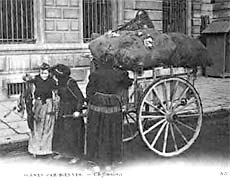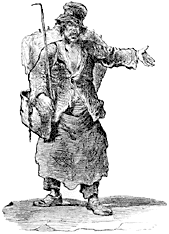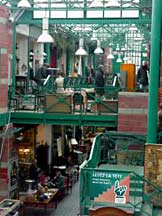 |
 |
 |
| |||||||||||||

|
|
|||
The World's Largest Flea Market Chiffonnières on Paris street around the turn of the century In the years between 1880 and 1900, the traveler who exited Paris via the Porte de Clignancourt would pass the sloping bank of Louis-Philippe's fortified city walls, the hovels of the rag-and-bone men, and the makeshift market stalls and inns set up in the middle of the fields and market gardens. It was against this colorful background, along the "passageway" which separated the capital from the town of Saint-Ouen, that the Flea Market set up its home. The history of the Flea Market traces back several centuries. It is inseparable from the history of the rag-and-bone men, who were to be found in the shadow of the so-called fortifs, or fortifications surrounding Paris. Known variously as chiffonniers (ragmen), biffins (rag-and-bone men), chiftires, crocheteurs (picklocks, housebreakers) or — more poetically — pêcheurs de lune (moonlight fishermen), they traveled through the city by night, searching for old objects that had been thrown out with the rubbish, which they would then resell at the local markets.  A rag-and-bone man In reaction to an outbreak of cholera around 1832, the city's authorities banned markets in the capital. Later, between 1853 and 1870, Baron Haussmann's aggressive urban planning drove many of the rag-and-bone men out of Paris. Some say that they were associated with the inhabitants of the "Cour des Miracles", an area of Paris frequented by beggars and thieves, but that is inaccurate. At any rate, the rag-and-bone men continued to pursue their activities on the other side of the fortifs, near the city gates of Montreuil, Vanves, Kremlin Bicêtre and Clignancourt. Gradually, a number of the craftier "moonlight fishermen" were able to become, in a sense, self-employed bric-a-brac traders. The area provided an additional benefit of being a "duty-free" zone, exempt from Paris taxes as it was outside the city limits. These traders soon decided to band together, and it was not long before the people of Paris gathered to gaze in wonder at the displays of miscellaneous objects spread out on the ground just beyond the gate at Clignancourt. Over time, the number of curious visitors steadily grew, as did the number of traders. It became fashionable, in fact, for a genteel population of collectors in their Sunday best to come and hunt for bargains among the bric-a-brac. The Flea Market was born! 1885: The Birth of the Flea Market Inside one of the market buildings at St-Ouen The beginnings of a regular scrap-metal market held on Sundays, which brought together no less than 130 traders, can be traced to between 1880 and 1890. It was the year 1885, however, which marked the official birth of the Flea Market — when authorities of Saint-Ouen took measures to clean up the area and make it safer. The times of the various markets held in the town were also coordinated. Work was carried out to facilitate the market's existence: roads were paved and walkways created along the major streets to help the traders set up their stalls and organize themselves better. The traders were now required to pay a fee in order to have the right to set up their stalls. In 1901, a town-planning project submitted to the local council included plans for a Flea Market on the corner of rue Marceau and rue des Rosiers. The Flea Market was granted what amounted to official recognition by being pictured on postcards, and a number of newspapers carried reports of the picturesque goings-on at the "Saint-Ouen Flea Market". The casual visitor leaving Paris by the Porte de Clignancourt, along the avenue Michelet and the Malassis pathways, would discover a market that was half-rural, half-urban, with flea marketer stalls standing side by side with those of traveling salesmen selling new goods.
Gradually, the little markets grew and attracted ever-growing numbers of bargain hunters. It soon became clear that the traders should be grouped together in a more coherent and better-organized area. The First Covered MarketAround 1920, shortly after the Great War, Romain Vernaison — who owned 2 acres (9,000m2) of land between the avenue Michelet, the rue des Rosiers and the rue Voltaire — decided to set up a whole series of pre-fabricated huts to be rented to the bric-a-brac dealers and the rag-and-bone men of the area. The first covered marketplace was born... Some time later, a certain Malik, reputed to be an Albanian prince, bought up an old restaurant called A Picolo in the rue Jules Vallès. Taking his cue from Romain Vernaison, he transformed the building into a marketplace with around a hundred stalls, which soon came to be known as the Malik Market. The market was, and remains, the place to come for second-hand clothes, old uniforms, helmets, cameras and so on.
By 1925, the fortifications had been almost completely demolished*. Not wishing to leave Saint-Ouen, a group of traders soon took over the Champ des Rosiers and set up a third marketplace, the Biron Market — two rows of around two hundred stalls running the length of an alley which stretches as far as the avenue Michelet before looping back in the shape of a hairpin. The Biron Market quickly became the more "distinguished" market, where one might find top quality old furniture, gilt wood, glassworks and porcelain. The Flea Market was extended yet further in 1938, when the Jules Vallès market was opened. After the Liberation, the opening days were set: Saturday, Sunday and Monday. Local shops were bought up by antiques dealers, bric-a-brac merchants or craftsmen who wanted to have an outlet near an organized market. As the years went by, the sector continued to grow, and other marketplaces were created, making up the mosaic of the world-renowned antiques market we know and love today. The Flea Market TodayThe Paris Saint-Ouen Flea Market celebrated its centenary in 1985. Hosting 2500 dealers and covering more than 17 acres (7 hectares), it is the world's largest antiques market. Every weekend, between 120,000 and 150,000 visitors from the world over come in the hopes of finding a rare and treasured object. The market has become one of the highlights of Paris for locals and tourists alike, looking for particular items or simply delighting in a stroll through the massive complex of vendors. In 2001, the entire Flea Market was declared a protected architectural heritage site — a Zone de Protection du Patrimoine Architectural Urbain et Paysager (ZPPAUP). No part of the site may be destroyed or transformed without the consultation of an architecte des bâtiments, an official architectural engineer.
*Note: today, the boulevard Périphérique, or ring-road encircling Paris, follows the route of the old city wall's ramparts. When exiting Paris, one passes beneath this road at Porte de Clignancourt to enter the Flea Market. (see map)
Edited by Ian C. Mills Sources: Les Puces de St-Ouen, a web site sponsored by ADPPSO — the association of flea market vendors. Pierre-Brice aux Puces de Saint-Ouen, a blog hosted by Pierre-Brice Lebrun, French journalist specializing in gastronomy and tourism. Paris Markets at wGuides.com, a travel portal web site. Maison de la France, a web site hosted by the French Government Tourist Office in New York City. Saint-Ouen Tourist Office. Images: Chiffonnières on Paris street around the turn of the century, from a postcard (photographer unknown) at Cheny le Grenier. "Le Chiffonnier" (rag-man), artist unknown, from Les Métiers de Nos Ancêtres, a web site hosted by D. Chatry. Inside one of the market buildings at St-Ouen, photographer unknown, from www.antikita.com © Antikita. Le Marché Biron, au coeur du Marché aux Puces (poster), from Marché Biron. All Rights Reserved. CONTINUED ON PAGE TWO » Directory of Flea Markets, Tourism Offices, and more... |
|||||||||||||||

|
||||||||||